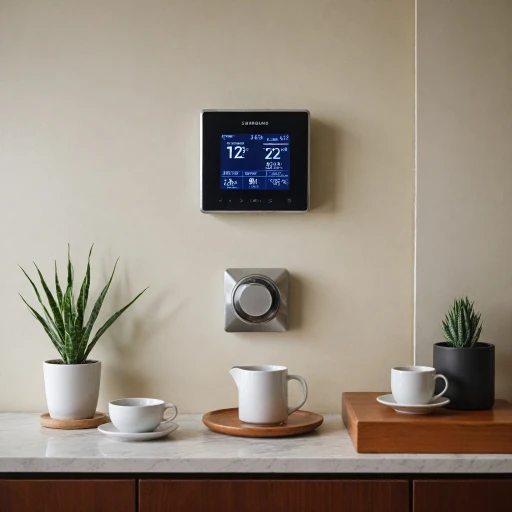Understanding the PSEG Smart Thermostat
Unveiling the Comprehensive Features
The PSEG Smart Thermostat is designed to seamlessly blend technology with energy efficiency. Whether you're located on Long Island or elsewhere, this smart thermostat offers a convenient way for customers to manage their home climate control. As part of PSE&G’s program, these thermostats are tailored to provide not just comfort, but also substantial energy savings and incentives.
Burrowing into the specifics, a PSEG Smart Thermostat can be compared favorably to some of the most popular thermostats available, like the Nest Thermostat and Ecobee Smart. It promises a host of smart features that make it a standout choice, fully embracing the advancements seen in smart home technology.
- Instant Energy Monitoring: The smart thermostat allows for real-time insights into energy use, helping consumers optimize their energy consumption patterns.
- Learning Abilities: Much like the Nest Learning Thermostat, this device adapts to your preferences over time, learning your schedule to adjust settings for maximum energy efficiency and comfort.
- Demand Response Capabilities: PSEG’s program includes demand response mechanisms that help in reducing energy load during peak periods, thereby increasing potential savings for customers.
- Seamless Integration: The utility’s smart thermostat not only connects with smart home systems but also integrates with platforms like Nest and Google Home, offering users a convenient, connected experience.
These smart thermostats, whether Nest or Honeywell, emphasize connectivity and user-friendliness. Additionally, PSEG's initiative, like the Smart Savers Thermostat Program, encourages adoption through rebates, giving customers a real incentive to upgrade and enjoy the benefits of a smart, connected home environment. If you're interested in understanding the broader integration possibilities, you'll find informative insights in the
benefits of consumers energy and Nest thermostat integration.
Energy Efficiency and Cost Savings
Maximizing Energy Efficiency and Reducing Costs
Incorporating a smart thermostat can significantly enhance energy efficiency and lead to notable cost savings for consumers. For customers on Long Island served by PSEG and other utility providers, adopting smart thermostats such as the Nest, Google Nest, or Ecobee Smart can be a game-changer.
Smart thermostats are designed to learn and adapt to your lifestyle, ensuring optimal temperature regulation without unnecessary energy expenditure. By understanding usage patterns, these devices can automatically adjust settings to align with times of peak and off-peak usage, which is a crucial feature of demand response programs.
Here are some potential benefits of integrating a smart thermostat:
- Connected Systems: Smart thermostats allow for integration with other smart home devices, offering centralized control and optimized functionality, reducing energy waste.
- PSE&G Rebate Programs: Utility providers like PSEG Long Island often offer rebate programs to encourage customers to adopt energy-efficient solutions. These rebates can offset the initial price of devices, making the transition to smart energy solutions more affordable.
- Instant Savings: By maintaining efficient temperature settings, smart thermostats quickly lead to energy savings. Reports demonstrate that with support from smart technology, households can achieve considerable reductions in heating and cooling costs over time.
It is noteworthy to mention that some utility providers may have terms and conditions regarding these energy-saving programs, so it's crucial to fully understand the thermostat program you are enrolling in.
Moreover, participation in a rewards program within these services may offer further discounts or benefits, thus amplifying the value derived from smart thermostat adoption. These insights into maximizing savings while enhancing sustainability can be explored further in
this comprehensive guide.
Integration with Smart Home Systems
Seamless Integration with Modern Smart Home Systems
The PSEG smart thermostat offers seamless integration with a variety of modern smart home systems, enhancing convenience and comfort for residents of Long Island. With its connected capabilities, the PSEG thermostat can easily sync with popular platforms such as Google Nest and Honeywell thermostats, making it a versatile choice for tech-savvy customers.
To participate in the PSEG smart savers program or benefit from potential rebate offers, integrating your smart thermostat into the home's existing infrastructure is crucial. The compatibility with various smart systems means that the thermostat can function harmoniously with other smart devices, offering not only potential energy savings but also a streamlined experience for users.
Moreover, PSEG customers can expect an instant enhancement in energy management. The thermostat's ability to connect seamlessly with utility demand response programs allows for better regulation of energy consumption, which can lead to significant cost savings.
When considering a smart thermostat, whether it’s a Google Nest or an Ecobee smart learning thermostat, the user must pay attention to the thermostat's ability to contribute to energy efficiency
enhancing efficiency. This ensures not only immediate savings but long-term benefits in terms of both energy use and overall home automation convenience. Furthermore, understanding the terms and conditions associated with different utility programs will help in maximizing the benefits offered by smart thermostats.
User-Friendly Features and Control
Convenient Features for Effortless Control
Smart thermostats like the PSEG variety offer a range of features that prioritize user convenience and control. These features make it easy for Long Island customers to maximize their energy savings and take advantage of utility programs.
One of the standout aspects is how these thermostats connect seamlessly with other smart home systems. Whether you have a Google Nest setup or a Nest Thermostat, integration is typically straightforward, allowing for interconnected smart management across devices.
These devices often come equipped with a user-friendly interface that provides instant access to temperature settings, usage data, and potential savings. Users can easily adjust and monitor their home environment from anywhere using a smartphone app, especially useful when dealing with unexpected weather changes or energy demand response notifications.
Moreover, smart thermostats are designed to learn your preferences over time. As they adapt, systems like the Nest Learning Thermostat deliver personalized comfort while optimizing energy efficiency.
Additionally, incorporating a PSEG smart thermostat into your home opens the door to various rebates and rewards programs. These incentives not only encourage adoption but also provide tangible benefits in terms of cost reduction and long-term savings. Through these programs, customers can offset the initial price and unlock additional potential savings, enhancing the overall utility and economic value of their investment.
Installation and Setup Process
Effortless Installation and Setup
Setting up your new PSEG smart thermostat is designed to be a hassle-free experience. It's engineered with user-friendliness in mind, making the transition to smarter energy management seamless. Here’s a straightforward guide to help you through the process:
- Prepare for Installation: Begin by ensuring you have the compatible HVAC system for the smart thermostat. Many popular models like Google Nest, Ecobee Smart, and Thermostat Honeywell are part of the PSEG program. Double-check the terms and conditions before proceeding.
- Turn Off Power: For safety, switch off the power to your heating and cooling system at the circuit breaker. This precaution prevents any potential accidents.
- Remove the Old Thermostat: Carefully dismantle your existing thermostat. Pay attention to the wiring as you'll need to reconnect these to the new unit.
- Mount the New Thermostat: Attach the new smart thermostat to the wall where your old one was located. Connect the wires according to the instructions. PSEG smart thermostats are designed to be compatible with most wiring configurations, but refer to the manual for any special instructions.
- Connect to Wi-Fi: Once installed, connect the thermostat to your home's Wi-Fi network. This step is crucial for enabling the smart features that allow remote management and participation in demand response programs aimed at energy savings.
- Register for the Program: If your smart thermostat is part of the PSEG Long Island Smart Savers program, complete the registration process. This allows you to access rebates and participate in potential rewards programs designed for PSEG utility customers.
- Configure Settings: Customize your thermostat settings to suit your preferences. Many models, such as the Nest Learning Thermostat, offer intuitive interfaces for setting schedules or integrating with Google for voice control.
- Test the System: Finally, turn the power back on and test your smart thermostat to ensure it connects properly with your heating and cooling system and is fully operational.
By following these steps, you can enjoy the immediate benefits like increased energy savings and participation in smart energy programs, without any installation headaches. Remember, if you encounter issues, the customer support provided by PSEG is always a resource available to help you resolve them quickly.
Troubleshooting Common Issues
Getting Your Smart Thermostat Up and Running
The installation process of the PSEG smart thermostat on Long Island can make all the difference when it comes to maximizing your energy savings and overall comfort. It's essential to follow the guidelines carefully to ensure your smart thermostat operates smoothly.
To start off, it’s advisable to verify whether the thermostat is compatible with your existing heating and cooling system. Popular models from brands like Google Nest, Ecobee, and Honeywell usually come with a set of installation instructions that PSE&G customers can follow. Long Island residents can also rely on customer support from PSEG or their smart thermostat providers for tailored assistance.
When installing, ensure that:
- The power to the HVAC system is completely turned off to avoid any electrical mishaps.
- All connections are secure and stable. This step is crucial to prevent connectivity issues with your smart thermostat program.
- The thermostat's sensors are positioned correctly for accurate temperature readings and effective utilization of learning features, such as Nest Learning.
Post-installation, the smart thermostat should automatically detect the setup. The next step involves connecting it to your home Wi-Fi network. This connection is critical for accessing advanced features like demand response programs, instant price alerts, and smart savers rewards.
Remember, the PSEG smart thermostat isn’t just about hardware. Its primary aim is to offer efficient energy consumption and cost savings. Being aware of potential rebates and savings programs, such as PSEG Long Island's Smart Savers, can further enhance your utility experience. Always read the terms and conditions associated with rebate programs to get the most out of these offerings, potentially earning savings that effectively reduce the overall cost of your smart thermostat.
In case you encounter any issues during the setup, check the instructional manual provided, explore FAQs, or report an outage through PSEG’s customer service. With the proper attention to these details, the transition to a smarter, more efficient home environment will be seamless.

